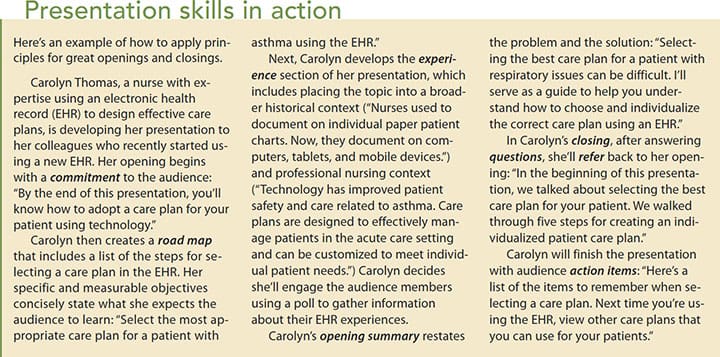Making a connection between your opening and closing engages the audience and enhances learning.
By Tresa Kaur, PhD, RN-BC, CNE, CHSE, CTN-A
Takeaways:
- Presentations are most effective when they start with a strong commitment to the audience with measurable objectives.
- Presentations should end with a restatement of the opening, a summary of information presented, and a follow-up call to action plan for audience members.
As a nurse, teaching includes sharing your expertise. Typically, you’re teaching to small audiences—an individual patient and a family member, which may make professional presentations to a larger audience more intimidating. Successful content delivery requires setting the right tone and ending with recommendations.
Presentation openings consist of four elements: commitment, experience, rules, and summary. Likewise, presentation closings have four elements: questions, referrals, summary, and call to action. In this article, I’ll share ways to start your opening with a commitment to your audience and end with a call to action.
Opening elements
 The opening sets the stage for the meat of your presentation. You want to get audience members’ attention, let them know who you are, and set their expectation.
The opening sets the stage for the meat of your presentation. You want to get audience members’ attention, let them know who you are, and set their expectation.
Commitment
Start your presentation with a commitment to your audience members by defining your purpose and offering a conclusion. Then draw a road map to the presentation conclusion. Provide stops and detours by carefully explaining how you’ll present the content and reach your goal. Keep your goals or objectives concise, specific, and measurable; use action verbs to engage the audience.
Experience
Nursing changes rapidly, so state your topic’s broader professional impact to underscore the importance of the presentation’s purpose.
Next, your audience should understand why you were chosen as the presenter on this topic. Ask yourself the following questions when designing this section:
- Why were you asked to present on this topic?
- Are you an expert in this field?
- What was the latest research that you reviewed?
- How else can you build trust with your audience?
Share personal anecdotes to help connect you with audience members, and provide visual aids, such as handouts, charts, posters, or slides with images, tables, and videos, to help them retain information. Refer to your anecdotes during the presentation to tie the discussion into a real-world setting. Some presenters use humor, quotes, and pictures as adjuncts to their anecdotes.
After presenting the global and personal perspective, you must tie them together. In many cases, offering a brief history lesson of the past and what’s coming in the future can help. Then conclude with a statement tying together how your personal perspective meets your professional obligations or standards of practice.
To keep the audience members engaged, ask for their perspectives on the topic. If it’s a newer topic, share a video, image, or a list, give them time to process, and then ask them to share their reactions with one another in pairs or small groups. Collect reactions and responses to show the audience members that you value their feedback, and refer to this list during the presentation. A poll is another way to share experiences, especially with an audience with whom you’re unfamiliar.
Rules
Lay out the rules of your presentation in the opening:
- presentation length
- audience participation requirements
- how you’ll handle questions (throughout or at the end).
Maintain eye contact with your audience throughout the presentation. This also is a good time check that all audience members can hear you, especially those in the back of the room.
Summary
Conclude your presentation opening by restating the problem and solution. Show an image or even a blank slide so the focus is on you. Remind the audience members about the purpose of the presentation and how you’ll help facilitate their growth and development in this content area.
Closing elements
The closing of your presentation should take your audience full circle, reminding them of the problem and the road map to the solution. In addition, you want to send audience members away with action items that will place what they learned in the real world of nursing.
Questions
Start your closing with audience member questions. However, be mindful of the time you’ll need to summarize your presentation and draw your audience’s attention to their action items.
Referrals
Refer to the beginning of your presentation, restating your goals and the steps for achieving them. Repetition helps with memory and content recall.
Summary
In the preceding step, you referred to the opening. Now is the time for a formal summary of the road map. A bulleted list or a one-sentence summary will do. You also should offer recommendations for further resources and learning opportunities.
Call to action
The last and most important part of your closing is the list of action items for participants. Give them a specific call to action and assign them “homework.” You might consider offering audience members a final “hands-on” task or assignment before they leave the presentation that gives them the opportunity to use the skills they learned. You want them to use cognitive and motor skills to help them better remember the information you presented.

Tying it all together
Your presentation should tie the opening and closing together. Carefully planning the content and using appropriate teaching strategies—such as slides, images, videos, lists, polls, and other interactive tools—will give your audience a meaningful learning experience. At the end of your presentation, gather feedback from your audience using a brief evaluation instrument that includes a question about the effectiveness of your opening and closing that you can use to help you improve your skills.
Tresa Kaur is a faculty member in the nursing doctorate in education program at Teachers College, Columbia University, in New York, New York.
Selected references
Foulkes M. Presentation skills for nurses. Nurs Stand. 2015;29(25):52-8.
Longo A, Tierney C. Presentation skills for the nurse educator. J Nurses Staff Dev. 2012;28(1):16-23.
ant2-Presentation-118a


















